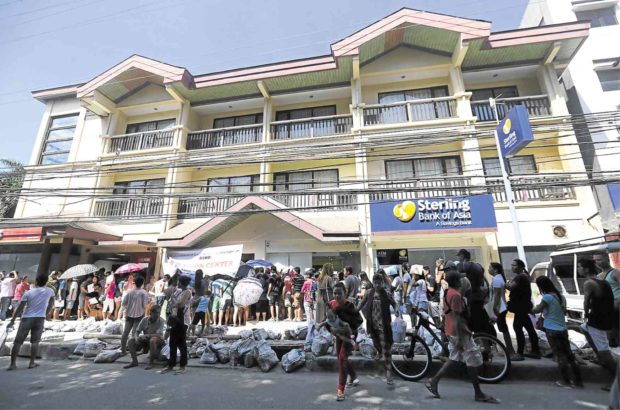
Long lines form at the DSWD Operations Center in Boracay as the six-month suspension of tourism activities on the resort island took effect on Thursday. —LYN RILLON
BORACAY ISLAND—Diounay Castillo had lined up as early as 6 a.m. at the assistance center of the Department of Social Welfare and Development (DSWD) inside a hotel here on Friday.
He was still waiting by 11:41 a.m., just one of several hundreds who had flocked to the center for transportation assistance to get home to their hometowns, where they hope to find temporary jobs while waiting out the six-month closure of the island.
The government closed Boracay starting April 26 to rehabilitate and restore the premium tourist destination which, it said, had become a “cesspool” because of improper sewage and garbage disposal.
The influx of applicants for assistance prompted the DSWD to deploy 90 personnel from its initial two in the island, extend the operating hours of its center and transfer it to a bigger venue.
DSWD officer in charge Emmanuel Leyco said the center would be open 24/7 to accommodate more applicants.
As of 9 p.m. Thursday, the agency had released about P3 million to 1,340 displaced workers, Leyco said, adding that a maximum of P5,000 in transportation assistance plus meal allowance would be given to validated applicants leaving for their home province.
Although the DSWD cannot provide assistance to the 36,000 registered and unregistered workers, Leyco said the agency will allot P540 million for dislocated residents and workers, which will be sourced from its own funds and the national calamity fund.
Castillo, 22, who had been a construction worker for three years on the island, hopes to go home to his hometown in Lezo, Aklan, to find work.
At least 17,000 registered workers and 19,000 informal workers—mostly from the island’s hotels, resorts, restaurants and other business establishments, as well as tricycle drivers, vendors, construction workers, tour guides and masseuses—were expected to lose their jobs because of the closure order.
Restaurant supervisor Rachel Joy Serdeñez, who had worked for eight years in Boracay, received P500 for fare and meal allowance for her trip back home to Culasi town in Antique.
“I have to find a temporary job and maybe raise pigs,” said Serdeñez who said she was supporting the schooling of a younger brother, an incoming third year college student.
The Department of Labor and Employment (Dole) has started its cash-for-work program, which involves providing temporary jobs to displaced informal workers for a maximum of 30 days, at the daily regional minimum wage of P323.50.
The Dole will also employ 5,000 informal workers, with an initial 1,000 already mobilized to help in the cleanup of Boracay’s three villages. Others will be tapped for coastal cleanup, clearing and reforestration activities.
In a related development, the Department of Public Works and Highways (DPWH) will be constructing wider, more pedestrian-friendly roads and better drainage systems as part of the island’s six-month rehabilitation, Public Works Secretary Mark Villar said in a statement.
“We aim to complete the whole Boracay circumferential road that will strictly follow the 6.10-meter carriageway standard and road right-of-way on both sides, as we also plan to build sidewalks and bike lanes for the pedestrians,” Villar said, adding that the three sections of the road with a total length of 5.2 kilometers, will cost P490 million. —WITH A REPORT FROM JULIE M. AURELIO